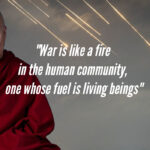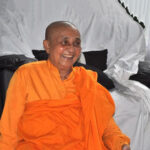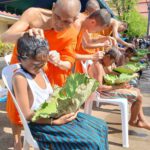?

Dr. B.R. Ambedkar painted on a wall in Bangalore, India
?
The Buddhist revival in India ignited by Dr. B.R. Ambedkar more than fifty years ago has brought millions of the country?s most impoverished and marginalized people to the Buddhist path. There is much we can learn from them, says Alan Senauke.
?




With justice on our side, I do not see how we can lose our battle. The battle to me is a matter of joy? For ours is a battle not for wealth or for power. It is a battle for freedom. It is a battle for the reclamation of the human personality.
? Dr. B.R. Ambedkar, All-India Depressed Classes Conference, 1942
Hidden in plain sight, a modern Buddhist revolution is gaining ground in the homeland of Shakyamuni. It’s being led by Indian Buddhists from the untouchable castes, the poorest of the poor, who go by various names: neo-Buddhists, Dalit Buddhists, Navayanists, Ambedkarites. But like so much in their lives, these names carry a subtle odor of condescension that suggests their kind of Buddhism is something less than the real thing.
In the children’s hostels and schools of Nagpur or modest viharas in Mumbai’s Bandra East slums and the impoverished Dapodi neighborhood in Pune, one finds people singing simple
When Ambedkar returned to India to practice law, he was one of the best-educated men in the country, but, as an untouchable, he was unable to find housing and prohibited from dining with his colleagues. Clerks tossed files onto his desk for fear of his “polluting” touch.
Pali chants, studying dharma, and meditating?with an image of the Buddha and a photo of Dr. B.R. Ambedkar adorned with garlands of fresh flowers. During a two-week visit to India, even in the grimmest of circumstances I could feel their joy in the dharma and their hunger for deeper practice and understanding. The Buddha was clear: ?I teach about suffering and the end of suffering.?
For those who suffer day after day, year after year, this message is hope itself. The 2001 census puts India?s Buddhist population at eight million, more than 90 percent from the untouchable communities; some scholars suggest that the number of uncounted or undeclared Buddhists is around thirty million. Buddhist communities are scattered across the nation, with the largest concentration in the state of Maharashtra.

Dalit children at a nursery school run by the Indian wing of Friends of the Western Buddhist Order (now called Triratna Buddhist Community)
?
?
?
?
?
?
?
?Jai Bhim!? is how Indian Buddhists greet each other. It means ?Victory to Bhim??the founder of their movement, Dr. Bhimrao Ramji Ambedkar.
Ambedkar was born in 1891 to a poor but educated family of Mahars, the largest untouchable caste in Maharashtra. Untouchables were excluded from many aspects of ordinary Hindu life, usually barred from entering temples, going to school, or even living within the boundaries of rural villages. Today, the numerous Dalit communities?differentiated by region, ethnicity, and subcaste?remain largely confined to occupations such as butchering, leatherwork, sweeping, and the removal of rubbish, human waste or dead animals. These jobs are seen as impure activities that are ?polluting? to higher castes, and that pollution is viewed as somehow contagious.
Fortunately for the young Ambedkar, his father served in the colonial Indian Army, and he became one of the first untouchables to attend an Indian university. By his early thirties he had earned doctorates from Columbia University and the London School of Economics, and a place at the bar in Gray?s Inn, a cornerstone of the British legal establishment. The extreme prejudice that Ambedkar experienced not only as boy, but later, despite his academic achievements, is hard for many of us in the West to imagine, even in light of our own history of racism. When he returned to India to practice law in Baroda, he was one of the best-educated men in the country, but, as an untouchable, he was unable to find housing and prohibited from dining with his colleagues. Clerks tossed files onto his desk for fear of his ?polluting? touch.

Caste means hereditary bondage passed from generation to generation under a dominant Brahmanic society. Contrary to the Buddhist meaning of thesesame words, in this Hindu system ?karma? means fate or the caste one is born into, and ?dharma? means the duty to live out one?s life within the confines of caste responsibilities. This duty includes strict endogamy, or marriage only within one’s caste. It was Ambedkar who dubbed the untouchables Dalits? meaning people who are “broken to pieces.” Other names have been suggested, each problematic, seen as demeaning by one group or another: Scheduled Castes and Scheduled Tribes?accounting for some 300 million people, or 25 percent of India’s population?are the sanitized terms used in the Indian constitution; untouchable is a legally proscribed status; ex-untouchable is euphemism. Mahatma Gandhi’s term harijan, which means “children of god,” is dismissed as patronizing by adults who hardly feel themselves blessed by any divine presence.
While Gandhi was forging a nonviolent anticolonial movement, Ambedkar?who often clashed with Gandhi?worked for human rights and the annihilation of caste as essential to what many saw as an otherwise elite-driven nationalism.
After years of attempted collaboration with reformist Hindus, including Gandhi, Ambedkar, a member of the Bombay legislature and a leader of the Mahar conference, organized a 1927 satyagraha (meaning, roughly, “truth force”) of thousands to draw water and drink from the Chowdar Tank, a reservoir
closed to untouchables despite a 1923 resolution of the Bombay Council. That same year, Ambedkar took the radical symbolic step of publicly burning the Manusmrti, the Brahmanic code of caste duty, which he and other Dalit leaders saw as key to the social, economic, religious, and political oppression of the untouchables.

?
Though untouchability was legally abolished under India’s secular constitution in 1950, the reality is not much improved today. Consider Hillary Maxwell’s report in a June 2003 edition of the online “National Geographic News”:
India’s untouchables are relegated to the lowest jobs, and live in constant fear of being publicly humiliated, paraded naked, beaten, and raped with impunity by upper-caste Hindus seeking to keep them in their place. Merely walking through an upper-caste neighborhood is a life-threatening offence.
Human rights abuses against these people, known as Dalits, are legion. A random sampling of headlines in mainstream Indian newspapers tells their story: “Dalit boy beaten to death for plucking flowers;” “Dalit tortured by cops for three days;” “Dalit ‘witch’ paraded naked in Bihar;” “Dalit killed in lock-up at Kurnool;” “7 alits burnt alive in caste clash;” “5 Dalits lynched in Haryana;” “Dalit woman angraped, paraded naked;” “Police egged on mob to lynch Dalits.”
?
?
?
Walking Buddha statue, nearly sixty feet tall, at Nagarjuna Training Institute,
also known as Nagaloka, in Nagpur
?
By 1935, Ambedkar had concluded that the Brahmanic caste system could not be reformed even with support from most liberal-minded Hindus. Caste oppression was not an artifact of Brahmanism, but rather its essence. Ambedkar urged the untouchables to give up the idea of attaining Hindu religious rights. He prepared to leave Hinduism and adopt another religion. He saw caste as a “system of graded inequality” in which each subcaste measured itself above some castes and below others, creating an almost infinite factionalism that divided each exploited community against another and making unity of social or political purpose almost impossible. “I was born a Hindu,” Ambedkar said, “but I solemnly assure you that I will not die as a Hindu.” He investigated Islam, Christianity, and Sikhism?and was courted by each of these groups, who were well aware that Ambedkar’s conversion would bring along millions of untouchables and the promise of wide political power.
?
From the start, Ambedkar’s Buddhism incorporated a vision of
a compassionate society and social liberation, far beyond the introspective
caricature that some have of Buddhism.
?
In the late forties, he decided that Buddhism?which was indigenous to India and had been the defining religious tradition for nearly 1,500 years before being virtually eradicated? was the logical home for his people. “The teachings of Buddha are eternal, but even then Buddha did not proclaim them to be infallible,” Ambedkar wrote.
“The religion of Buddha has the capacity to change according to times, a quality which no other religion can claim to have… Now what is the basis of Buddhism? If you study carefully, you will see that Buddhism is based on reason. There is an element of flexibility inherent in it, which is not found in any other religion.”
 |
| Mangesh Dahiwale, a young leader of the Manuski Project in Pune |
?
Ambedkar’s plans for conversion were postponed while he served as India’s first law minister and leader of the constitutional drafting committee. Then, in the early fifties, setting aside his political career, he plunged into the study of Buddhism and its application to the shaping of a new Dalit identity. After long consideration and consultation, and in ill health, feeling the shadow of mortality, he converted in a public ceremony in Nagpur on October 14, 1956, taking the three refuges of the Buddha, dharma, and sangha, and receiving the pancasila, or five ethical precepts, from the most senior Buddhist monk in India, U Chandramani. He then did something unprecedented. Turning to the 400,000 of his followers who were present, he offered them the three refuges and his own twenty-two vows, which included the five precepts and the renunciation of specific articles of Hindu practice and belief. This signaled a momentous renewal of Buddhism in India. A number of mass conversions followed within weeks.
Not quite two months later, Ambedkar was dead, felled by complications from diabetes and heart disease.
?
?
The New Buddhist Movement and TBMSG
 |
| Dalit woman and son outside a shop in Pune |
The death of Ambedkar, or Babasaheb, as his devotees call him, left the nascent Dalit spiritual and political movement without unified leadership. It was not surprising to see the rapid rise of factionalism, given the entrenched system of graded inequality. No one else on the scene had the intellect and strength of character with which to unify the many outcast communities.
“People looked at Dr. Babasaheb Ambedkar as a kind of guide or guru or philos
opher who would lead them after conversion,” says Mangesh Dahiwale of the Manuski Center, an Ambedkarite hub in Pune. (Manuski is the Marathi word Ambedkar used for “humanity” or “humanness.”) Ambedkar’s book The Buddha and His Dhamma came out a year after his death. “It became a source to which people turned in order to understand Buddhism,” Dahiwale says.
“It was published in English first, and soon translated into Marathi and Hindi. That book was a guide, and people began to read it and study it in groups.”

Students attending a ten-month leadership program in basic Buddhism and social action at Nagaloka
In Ambedkar’s day there were virtually no Buddhist teachersin India, but “people flocked around the Sri Lankan and BurmeseBuddhists?anyone who could offer Buddhist teachings,”Dahiwale says. “If they found a bhikkhu, they would gatheraround and try to unders
tand what Buddhism is. In fact someof the people from the Ambedkarite movement, in the 1950s,became monks in India, ordained in a Sri Lankan tradition.”
Still, the process that Ambedkar set in motion was incomplete.From 1956 until the early eighties, there was little continuingeducation or practice available to millions who hadconverted. But the right seeds had been planted.
?Babasaheb Ambedkar had created the Bhartiya BauddhaMahasabha, or the Buddhist Society of India, in 1955,? Dahiwalesays. ?The first mass conversions were held under theirauspices. But for the most part, these were local initiatives.The start of this movement was grassroots and Indian-led.There were no teachers or prominent leaders; ordinary peopletook the initiative. Even though Dr. Ambedkar was not there,his inspiration was there. People tried to do what they could. Mainly they were very poor, facing discrimination, but theytried to keep the flame alive.?
This network of local viharas and practitioners, scatteredacross Maharastra state and other parts of India, allowed theyoung English monk Ven. Sangharakshita to connect with theDalit Buddhist movement. Sangharakshita met with Ambedkarseveral times, and when he happened to be in Nagpur onthe evening that Ambedkar died in Delhi, he was asked to bea speaker at a meeting of condolence.
?By the time I rose to speak?standing on the seat of a rickshaw,and with someone holding a microphone in front of me?about 100,000 people had gathered,? Sangharakshita says. ?Byrights, I should have been the last speaker, but as things turnedout I was the first. In fact, I was the only speaker. Not that thereweren?t others who wanted to pay tribute to the memory of thedeparted leader. One by one, some five or six of Ambedkar?smost prominent local supporters attempted to speak, and oneby one they were forced to sit down again as, overcome byemotion, they burst into tears after uttering only a few words.?
From this moment, Sangharakshita says his sense ofpersonal responsibility was clear. ?During the decade that followed, I spent much of my time with the ex-untouchableBuddhists of Nagpur, Bombay [Mumbai], Poona [Pune],Jabalpur, and Ahmedabad, as well as with those who livedin the small towns and villages of central and western India.I learned to admire their cheerfulness, their friendliness, theirintelligence, and their loyalty to the memory of their greatemancipator.?
Returning to Britain, where he founded the Friends of theWestern Buddhist Order (FWBO), now called the TriratnaBuddhist Community, Sangharakshita kept thinking about theDalit Buddhists and his friends in India. Heencouraged a young disciple, DhammachariLokamitra, to visit India and work with theAmbedkarite Buddhists.
 |
|
Dhammachari Lokamitra, a foundingteacher of TBMSG, at home in Pune |
Lokamitra is a tall, solid, and youthfullookingEnglishman with an easy laugh and aquick mind. His energy at sixty-two hints at akind of wildness tempered by years of dharmapractice. He lives with his family in a modesthouse in the Ambedkar Colony settlement in Pune. Since 1978, he has helped to build a movement, TrailokyaBauddha Mahasangha Sahayaka Gana (TBMSG), the Indianwing of FWBO, and a variety of related social organizations,all of which aimed to develop a new Indian or AmbedkariteBuddhism, fusing dharma practice and social action.
Lokamitra came to India in 1977 to study yoga with B.S.Iyengar in Pune. He decided to break up the long train trip fromKolkata by stopping over in Nagpur, and arrived by chance onthe twenty-first anniversary of the day Ambedkar led the Dalitsinto Buddhism. As an FWBO angarika, wearing robes, he foundhimself on a large stage facingthousands of devotees.
?In the thirty-six hours wespent in Nagpur, I entered anew world, a world of millionsof the most oppressed people, all desperate to transform their lives and their society throughBuddhism, but with little living teaching to guide them,? Lokamitrarecalls. ?I had stumbled blindly into a situation in whichthe two-fold transformation seemed a real possibility, and onthe most auspicious of days. I did not consciously decide to liveand work in India then but I have no doubt that my future wasdecided on that day.?
Lokamitra moved to India the following year, and with helpof local Indian Buddhists he organized retreats and meditationgroups. ?Our friends,? he says, ?organized these where theycould?an abandoned disused railway carriage, the verandaof an unfinished police station, a small garage when its carwent to church on Sundays.?
More than thirty years have passed since those rough andready days. TBMSG now includes more than five hundredordained dharma teachers?dharmacharis and dharmacharinis?and many thousands of practitioners. With the support ofthe Karuna Trust and other donors in Asia and the West, tworelated organizations?Jambudvipa Trust and Bahujan Hitay(meaning ?for the welfare of many?)?evolved to do outreach and social work among the Dalits. As well, MaitreyanathDhammakirti, Mangesh Dahiwale, Priyadarshi Telang andother TBMSG leaders established the Manuski Center (alsoknown as the Manuski Project) in Pune. The center is quietand cool, with a good library, meeting rooms, offices, basic butcomfortable guest rooms, and a large meditation hall.
?
During my visit to India, I stayed at Manuski and gaveworkshops on engaged Buddhism. I also met with studentsat the Nagaloka education center, took part in a study retreatin Kondhanpur, and offered dharma talks in Nagpur andMumbai. Each activity included melodic Pali chanting andmeditation.
The Dalit Buddhist meditation practices are straightforwardand familiar to me: anapanasati, or mindfulness of breathing,and metta bhavana, or cultivation of loving-kindness. I sensea quality of concentration and settledness. City sounds risewithin the silence of meditation?children?s shouts, pantingrickshaw drivers, barking dogs, the crack of a cricket bat, astreet vendor?s cry. The peace of meditation at once includesall of this and goes beyond it. Half a world away from California, I feel completely at home. Theordinariness is amazing: sitting with friends in the middle ofan urban jungle.
?
I was inspired by the students at Nagaloka. Despite having been involvedin engaged Buddhism for more than twenty years, nowhere elsehave I met young people with the kind of intuitive grasp of Buddhist practiceand social action arising together.
?
?
Liberty, Equality, Fraternity
In 1991, when I came to work at Buddhist Peace Fellowshipin Berkeley, engaged Buddhism was outside the mainstream.Twenty years later, countless centers and groups are involvedin prison work, chaplaincy, feeding the poor, and organizingagainst war. We have come to see this as a responsibility thatflows from the bodhisattva vow to save all beings. But fromthe start, Ambedkar?s Buddhism incorporated a vision of acompassionate society and social liberation, far beyond theintrospective caricature that some have of Buddhism. So itis natural that an Indian Buddhist movement, rooted in themost oppressed segment of society, would see the oneness ofpersonal development and social transformation.
In an All-India Radio broadcast two years before his conversion,Ambedkar said: ?Positively, my social philosophy maybe said to be enshrined in three words: liberty, equality, andfraternity. Let no one, however, say that I have borrowed myphilosophy from the French Revolution. I have not. My philosophyhas its roots in religion and not in political science. I havederiv
ed them from the teachings of my master, the Buddha.?

New Buddhist students attending class at Nagaloka
?
Fraternity is the cutting edge of Ambedkar?s Buddhismand the new Buddhist movement. Fraternity is sangha, thecommunity of practitioners, and the wider community of allbeings, and as such, it is linked to equality. However, fraternityis a challenge for the Dalit community. It challenges themjust like race, class, and diversity challenge Western Buddhists.The social realities of India draw clear lines between all thereligions?Hindu, Muslim, Sikh, Christian, and Buddhist;between caste and noncaste; and, most critically, between themany Dalit groups themselves within the system of ?gradedinequality,? each group scrambling for the tiniest privilegesof social position, economic opportunity, and political power.Fraternity is what connects us. And we know this is hard work.
The Manuski Project is ?action central? for Dalit socialwork. Its mission has four main aspects: transcending castebarriers; fighting social discrimination; developing Dalitwomen leadership; and building solidarity. A network ofrelated organizations has developed in Maharashtra, AndhraPradesh, Uttar Pradesh, Gujurat, and Tamil Nadu. Projectsinclude education for both children and adults, civil rightswork, and earthquake and tsunami relief.
Free inquiry and gender equality are points that Ambedkaridentified as the essence of Buddhism??I measure theprogress of a community,? he said, ?by the degree of progresswhich women have achieved??and women now lead manyof the social projects. In slums and poor villages, Ambedkarite Buddhist women are leading schools, hostels, social work, anddharma communities as teachers or dharmacharinis in theirown right. There are more than ninety women teachers in TBMSG. But the movement still needs to have more women invisible leadership, which means participating equally in publicevents and internal organizational structures.
Nagaloka, or the Nagarjuna Training Institute, is TBMSG?s flagship educational project, the largest of its centers. Theinstitute has a fifteen-acre campus on the outskirts of Nagpur.At night, from a distance, one can see the tall golden image ofa walking Buddha that smiles down on the students.
The institute offers a ten-month leadership training programin basic Buddhism and social action for young Dalitsfrom all religious communities. About five hundred youngpeople from twenty Indian states have graduated from theprogram over the last eight years. Most of these students havegone back to their villages to work on campaigns againstsocial oppression, offer dharma teachings, and support otheryoung people so that they too can live and train in Nagaloka.These students come from caste-based villages where life is stillmarked by discrimination and violence. Even as I write, CNNreports the murder of an Indian politician in Uttar Pradesh,shot as he attended a ceremony marking Ambedkar?s birth.
For many of these students, leaving home for the first timeis unsettling and difficult. Each one arrives with a commonyearning to see the world and to be of use, but growing upwithin oppressive traditional cultures leaves them unpreparedfor the cultural shock of a new life at Nagaloka. Some of themare overwhelmed, but most find their way into student life,buoyed by new friends and teachers and practicing dharma.
One young student recounted: ?In my childhood I observedthis caste system all the time. My grandmother had to takewater from the village well. But when she put her bucket in,other community people saw that and would not take wateruntil the well was purified by rituals. If someone asked you totheir home for food, if you were Dalit, you had to wash yourown plate. My father often used to do that. Once I was invitedfor dinner, but I refused to wash my plate. They asked why Iwouldn?t wash it. I said, if you invite me to eat with you, it isnot right to force me to wash my own plate. In that case, I cangive up your food and go. So I just left.?
A woman of twenty said: ?I am from Orissa. Where I livethere is still a very strong caste system. They don?t allow Dalitchildren to get any kind of education. If a girl tries to get aneducation, their parents become afraid and get them marriedquickly. Neighborhood people will not allow the girls to learnas they wish to. We are here at Nagaloka now, but my familydoesn?t know we are learning Buddhism. When we go backto the village we will share with them what we have learnedabout the dharma. We came with the help of former students,and when we go back we will help find other students. I really believe that our training at Nagalokawill benefit our community.?
The school explains its mission thisway: ?The different Scheduled Castecommunities in India do not usuallycooperate with each other, even afterthey have become Buddhists. At theNagarjuna Training Institute, theyrelate to each other just as Buddhistsand not in terms of the caste they havecome from. This in itself is an enormouscontribution to a truly democratic society.The intensive practice for a yearwith other Buddhists from all overIndia means they cease to identify withthe old untouchable caste but just asBuddhists.?
I was inspired by the students atNagaloka. Meeting them over severaldays, their stories touched me. Theirway-seeking minds glow with the spiritof inquiry. Despite having been involvedwith engaged Buddhism for twentyyears, nowhere else have I met youngpeople with their kind of intuitive graspof Buddhist practice and social actionarising together. Nowhere else have Ihad deeper discussion that never slippedinto abstraction, but focused on theconditions of oppression these studentsknow only too well. Nowhere else haveI encountered anything like their determinationto remake the world in peace.My heart is with them.
There is much in this new IndianBuddhism that we share in the West.On both sides we have turned to thedharma in response to the Buddha?scentral message about suffering andthe end of suffering. Knowingly or not,many of us in the West come to Buddhismto deal with suffering, oftenalienated from the religious traditionswe were born into. For Dalits, whosematerial circumstances may be so differentfrom ours, the motivation is thesame: to learn about suffering and toreach its end, in each person?s life andin society. As well, what I call the ?threemarks? of Western Buddhism?a largelylay movement, feminization, and social action?are shared by Ambedkarites.With all that we have in common, it ispainful that Indian Buddhism is almostinvisible to other Buddhists around theworld. The time has come for us to seethat a vast engaged movement in Indiapromises to change the way Buddhismis seen by all the world?s religions.
PHOTO Phil clevenger






